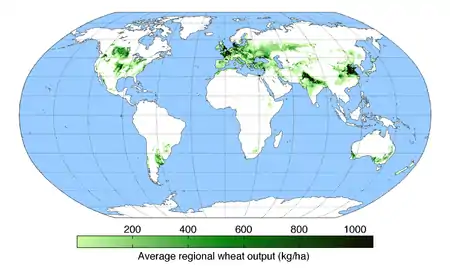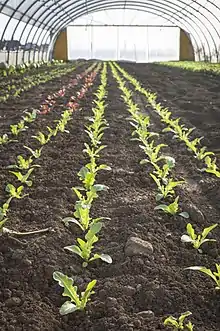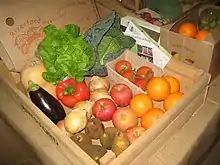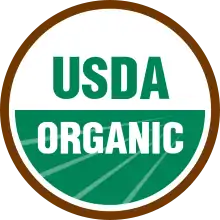Food system
The term food system is used frequently in discussions about nutrition, food, health, community, economic development and agriculture. A food system includes all processes and infrastructure involved in feeding a population: growing, harvesting, processing, packaging, transporting, marketing, consumption, distribution and disposal of food and food-related items. It also includes the inputs needed and outputs generated at each of these steps. A food system operates within and is influenced by social, political, economic, and environmental contexts. It also requires human resources that provide labor, research and education. Food systems are either conventional or alternative according to their model of food lifespan from origin to plate.[1][2][3]
According to the IPCC, the global food system, including all of the various industries involved in sustainable and conventional food systems, provide employment for 1 billion people.[4] This global food system is facing a number of challenges created by impeding global food security issues created by climate change and non-climate change stresses on the system.[4] Between 21-37% of total greenhouse gas emissions are attributable to the global food system,[4] and in 2020 an EU evidence review found that this is on course to increase by 30–40% by 2050 due to population growth and dietary change.[5] Transitioning to sustainable food systems is an important step to addressing these global challenges.
Conventional food systems
Conventional food systems operate on economies of scale. These food systems are geared towards a production model that requires maximizing efficiency in order to lower consumer costs and increase overall production, and they utilize economic models such as vertical integration, economic specialization, and global trade.
The term “conventional” when describing food systems is in large part due to comparisons made to it by proponents of other food systems, collectively known as alternative food systems.
History of conventional food systems
The development of food systems can be traced back to the origins of in-situ agriculture and the production of food surpluses. These surpluses enabled the development of settled areas and contributed to the development of ancient civilizations, particularly those in the Fertile Crescent.[6] The system of trade associated with the exchange of foodstuffs also emerged in East Asia, North America, South America, and Subsaharan Africa with common commodities of exchange such as salt, spices, fish, grains, etc.[7] Through events in world history such as the conquests of Alexander the Great, the Crusades, the expansion of Islam, the journeys of Marco Polo, and the exploration and colonization of the Americas by Europeans led to the introduction and redistribution of new foods to the world at large, and food systems began to intermingle on a global scale. After World War II, the advent of industrialized agriculture and more robust global trade mechanisms have evolved into the models of food production, presentation, delivery, and disposal that characterizes conventional food systems today.[8]
Impacts of conventional food systems
Lower food costs and greater food variety can be directly attributed to the evolution of conventional food systems. Agronomic efficiency is driven by the necessity to constantly lower production expenses, and those savings can then be passed on to the consumer. Also, the advent of industrial agriculture and the infrastructure built around conventional food systems has enabled the world population to expand beyond the "Malthusian catastrophe" limitations. According to the IPCC, food supply per capita has increased by more than 30% since 1961.[4]
However, conventional food systems are largely based on the availability of inexpensive fossil fuels, which is necessary for mechanized agriculture, the manufacture or collection of chemical fertilizers, the processing of food products, and the packaging of the foods.[9] The increase in availability of food since 1961 has largely been driven by an 800% increase in use of nitrogen fertilizers (which are fossil fuel dependent) and high water usage (an increase of over 100% since 1961).[4]
The impacts of these resource intense processes are many a varied: food processing began when the number of consumers started growing rapidly. The demand for cheap and efficient calories climbed resulting in nutrition decline;[9] and industrialized agriculture, due to its reliance on economies of scale to reduce production costs, often leads to the compromising of local, regional, or even global ecosystems through fertilizer runoff, nonpoint source pollution,[10] and greenhouse gas emission.
The need to reduce production costs in an increasingly global market can cause production of foods to be moved to areas where economic costs (labor, taxes, etc.) are lower or environmental regulations are more lax, which are usually further from consumer markets. For example, the majority of salmon sold in the United States is raised off the coast of Chile, due in large part to less stringent Chilean standards regarding fish feed and regardless of the fact that salmon are not indigenous in Chilean coastal waters.[11] The globalization of food production can result in the loss of traditional food systems in less developed countries, and have negative impacts on the population health, ecosystems, and cultures in those countries.[12] As a result of these forces, 2018 estimates suggest that 821 million people are currently undernurished, and 2 billion adults are overweight and obese.[4]
The issue of having minimal access to food, or access to primarily unhealthy food, are often described in terms of food security. The 1996 World Food Summit defined food security as a state in which "all people, at all times, have physical and economic access to sufficient, safe and nutritious food to meet their dietary needs and food preferences for an active and healthy life. "[13] Many groups argue that food security is largely determined by a given person's socioeconomic status, race, ethnicity, or other socially defined category, making food access a social justice issue. This has given rise to numerous social movements whose goal is to increase access to healthy and culturally appropriate foods, among a wide variety of groups. These movements are often described as belonging to a larger food justice movement.
Alternative food systems
Alternative food systems are those that fall outside the scope of conventional agriculture, typically in order to create sustainable food systems.
Local food systems

Local food systems are networks of food production and consumption that aim to be geographically and economically accessible and direct. They contrast to industrial food systems by operating with reduced food transportation and more direct marketing, leading to fewer people between the farmer and the consumer. As a result, relationships that are developed in local food systems emerge from face-to-face interactions, potentially leading to a stronger sense of trust and social connectedness between actors.[14] In addition to this, consumers can also encourage farmers to be environmentally friendly by teaching them about practices such as organic farming.[15] As a result, some scholars suggest that local food systems are a good way to revitalize a community.[16] The decreased distance of food transportation has also been promoted for its environmental benefits.[17] Also, farmers can enjoy a better quality of life because producing healthier food will allow them to be paid more, and not live under the poverty line.[18]
Both proponents and critics of local food systems warn that they can lead to narrow inward-looking attitudes or ‘local food patriotism’,[19] and that price premiums and local food cultures can be elitist and exclusive.[20] In contrast, many food sovereignty activists argue that local production of food is essential to achieving food security, especially among indigenous communities, and thus are crucial to the public health of those communities.[21]
Examples of local food systems include community-supported agriculture, farmers markets and farm to school programs. They have been associated with the 100 Mile Diet and Low Carbon Diet, as well as the slow food movement. The food sovereignty movement is also related to local food production. Food sovereignty activists argue that local communities should not only have access to nutritious and culturally appropriate foods, but that those communities should also be able to define the means by which their food is produced.[22] Various forms of urban agriculture locate food production in densely populated areas not traditionally associated with farming. Garden sharing, where urban and suburban homeowners offer land access to food growers in exchange for a share of the harvest, is a relatively new trend, at the extreme end of direct local food production.
Organic food systems
Organic food systems are characterized by a reduced dependence on chemical inputs and an increased concern for transparency and information. Organic produce is grown without the chemical pesticides and fertilizers of industrial food systems, and livestock is reared without the use of antibiotics or growth hormones. The reduced inputs of organic agriculture can also lead to a greater reliance on local knowledge, creating a stronger knowledge community amongst farmers.[23][24] The transparency of food information is vital for organic food systems as a means through which consumers are able to identify organic food.[25] As a result, a variety of certification bodies have emerged in organic food systems that set the standards for organic identification. Organic agriculture is promoted for the ecological benefits of reduced chemical application, the health benefits of lower chemical consumption, the economic benefits that accrue to farmers through a price premium, and the social benefits of increased transparency in the food system.
Like local food systems, organic food systems have been criticized for being elitist and inaccessible. Critics have also suggested that organic agriculture has been conventionalized such that it mimics industrial food systems while using pesticides and fertilizers that are organically derived [26]
Cooperatives in food systems



Cooperatives can exist both at the farmer end of food production and the consumer end. Farming cooperatives refer to arrangements where farmers pool resources, either to cultivate their crops or get their crops to market. Consumer cooperatives often refer to food cooperatives where members buy a share in the store. Co-operative grocery stores, unlike corporate grocery stores, are socially owned and thus surpluses cannot be taken from the store as profit. As a result, food co-ops do not work for profit, potentially keeping prices more cost representative. Other forms of cooperatives that have developed more recently include community-supported agriculture, where community members buy a share in a farm’s harvest, and may also be engaged in farm labour, operating at both the consumer and producer end of food systems. Garden sharing pairs individual landowners and food growers, while variations on this approach organize groups of food gardeners for mutual assistance.
The benefits of cooperatives are largely in the redistribution of risk and responsibility. For farming cooperatives that share resources, the burden of investment is disbursed to all members, rather than being concentrated in a single individual. A criticism of cooperatives is that reduced competition can reduce efficiency[27]
Fair Trade
.png.webp)
Fair trade has emerged in global food systems to create a greater balance between the price of food and the cost of producing it. It is defined largely by more direct trading and communication systems whereby producers have greater control over the conditions of trade and garner a greater fraction of the sale price. The main goal of Fair Trade is to "change international commercial relations in such a way that disadvantaged producers can increase their control over their own future, have a fair and just return for their work, continuity of income and decent working and living conditions through sustainable development" [29] Like organic food systems, fair trade relies on transparency and the flow of information.[30] Well-known examples of fair trade commodities are coffee and cocoa.
Climate change
Effects of climate change
The IPCC Special Report on Climate Change and Land describes the current global food system as potentially having major food security risks due to changes created by climate change, including changing local weather conditions, socioeconomic effects of climate change, vulnerability of certain types of agriculture (such as pastoral) and changes in diets due to availability.[4]
Effects on climate change
.jpg.webp)
The food system is one of the largest sources of greenhouse gas emissions, attributable for between 21-37% of global emissions.[4] In 2020, an evidence review for the European Union's Scientific Advice Mechanism found that, without significant change, emissions would increase by 30–40% by 2050 due to population growth and changing consumption patterns, and concluded that "the combined environmental cost of food production is estimated to amount to some $12 trillion per year, increasing to $16 trillion by 2050".[31] Another 2020 study concluded that reducing emissions from the global food system to be essential for achieving the Paris Agreement's climate goals.[32][33]
The IPCC's and the EU's reports concluded that adapting the food system to reduce greenhouse gas emissions impacts and food security concerns, while shifting towards a sustainable diet, is feasible .[4]
Public policy
European Union
The European Union's Scientific Advice Mechanism has published a systematic review of all European policies related to sustainable food systems, and their analyses in the academic literature.[34]
In September 2019, the EU's Chief Scientific Advisors stated that adapting the European food system for the future should be a high priority for the EU:[35]
Although availability of food is not perceived as an immediate, major concern in Europe, the challenge to ensure a long-term, safe, nutritious and affordable supply of food, from both land and the oceans, remains. A portfolio of coordinated strategies is called for to address this challenge.
In January 2020, the EU put improvements to the food system at the core of the European Green Deal. The European Commission's 'Farm to Fork strategy for a sustainable food system', due to be published in spring 2020, is expected to lay out how European countries will reduce greenhouse gas emissions, protect biodiversity, reduce food waste and chemical pesticide use, and contribute to a circular economy.[36]
In April 2020, the EU's Scientific Advice Mechanism delivered to European Commissioners a Scientific Opinion on how to transition to a sustainable food system, informed by an evidence review report undertaken by European academies.[37]
Transparency
Transparency within food systems refers to full disclosure of information about rules, procedures and practices at all levels within a food production and supply chain.[38] Transparency ensures that consumers have detailed information about production of a given food item. Traceability, by contrast, is the ability to trace to their origins all components in a food production and marketing chain, whether processed or unprocessed (e.g., meat, vegetables) foods. Concerns about transparency and traceability have been heightened with food safety scares such as bovine spongiform encephalopathy (BSE) and Escherichia coli (E. coli), but do not exclusively refer to food safety. Transparency is also important in identifying foods that possess extrinsic qualities that do not affect the nature of the food per se, but affect its production, such as animal welfare, social justice issues and environmental concerns.[39]
One of the primary ways transparency is achieved is through certification and/or use of food labels. In the United States, some certification originates in the public sector, such as the United States Department of Agriculture (USDA) Organic label. Others have their origin in private sector certification (e.g., Humanely Raised, Certified Humane). There are also labels which do not rely on certification, such as the USDA's Country of Origin Label (COOL).
Participation in local food systems such as Community Supported Agriculture (CSA), Farmers Markets, food cooperatives and farmer cooperatives also enhances transparency, and there are diverse programs promoting purchase of locally grown and marketed foods.
Labeling
 USDA Organic Label |
Organic (USA) – The USDA Organic label indicates that the product has been produced in accordance with the USDA's Federal Organic Standard. This label is applied to fruits, vegetables, meat, eggs and dairy products. Some states, such as California, have their own organic label. Organic labelling is prominent internationally as well. |
 Fair Trade Show in UK |
Fair Trade – Indicates that the product has been grown and marketed in accordance with Fair Trade standards. This is an independent certification, awarded by FLO-CERT and overseen by FLO International. Major food items that are marketed under Fair Trade are coffee, tea and chocolate. Many items other than food are sold with a Fair Trade label. |
| Food Alliance Certified – Food Alliance is a nonprofit organization that certifies farms, ranches, and food processors and distributors for safe and fair working conditions, humane treatment of animals, and good environmental stewardship. Food Alliance Certified products come from farms, ranches and food processors that have met meaningful standards for social and environmental responsibility, as determined through an independent third-party audit. Food Alliance does not certify genetically modified crops or livestock. Meat or dairy products come from animals that are not treated with antibiotics or growth hormones. Food Alliance Certified foods never contain artificial colors, flavors, or preservatives.[40] | |
Examples of COOL Labeling |
Country of Origin – This label was created by enactment of the 2002 Farm Bill. The US Department of Agriculture is responsible for its implementation, which began 30 September 2008. The bill mandates country of origin labeling for several products, including beef, lamb, pork, fish, chicken, perishable agricultural commodities and some nuts. USDA rules provide specifics as to documentation, timetables and definitions.[41] There is not one specific label to indicate the country of origin; they will vary by country. |
| American Humane Certified – This certification is provided by the American Humane Association, and ensures that farm animals are raised according to welfare standards that provide for adequate housing, feed, healthcare and behavior expression. Antibiotics are not used except for therapeutic reasons; growth promoters are not used. Other issues including transport, processing and biosecurity are addressed as well. Species covered are poultry, cattle and swine.[42] | |
| Certified Humane Raised & Handled – This label ensures that production meets the Humane Farm Animal Care Program standards, which addresses housing, diet (excluding routine use of hormones or antibiotics) and natural behavior. Additionally, producers must comply with food safety and environmental protection regulations. They must meet standards set by the American Meat Institute, that are more stringent than those laid out in the Federal Humane Slaughter Act. Certification has been applied to beef, poultry and eggs, pork, lamb, goat, turkey, veal, dairy products and wool.[43] |
See also
Notes and references
- "A Primer on Community Food Systems: Linking Food, Nutrition and Agriculture" (PDF). Farmland Information Center. n.d. Retrieved 2019-01-12.
all processes involved in keeping us fed: growing, harvesting, processing (or transforming or changing), packaging, transporting, marketing, consuming and disposing of food and food packages.
- Ericksen, Polly J. (February 2008). "Conceptualizing food systems for global environmental change research" (PDF). Global Environmental Change. 18 (1): 234–245. doi:10.1016/j.gloenvcha.2007.09.002. Retrieved 2019-01-12.
- Development Policy Review, 2003, 21 (5-6): 531-553 Food Policy Old and New - Simon Maxwell and Rachel Slater∗
- Mbow, C.; Rosenzweig, C.; Barioni, L. G.; Benton, T.; et al. (2019). "Chapter 5: Food Security" (PDF). IPCC SRCCL 2019. pp. 439–442.
- Science Advice for Policy by European Academies (2020). A sustainable food system for the European Union (PDF). Berlin: SAPEA. p. 39. doi:10.26356/sustainablefood. ISBN 978-3-9820301-7-3.
- (2004); Manning, R.; Against the Grain: How Agriculture Hijacked Civilization, New York:North Point Press
- (1994); Toussaint-Samat, M. and Bell, A.; A History of Food ; Blackwell Publishing
- (1998); Welch, R., Graham, R.; "A new paradigm for world agriculture: meeting human needs, Productive, sustainable, nutritious"; Field Crops Research #60,.
- Nestle, Marion. (2013). Food Politics: How the Food Industry Influences Nutrition and Health." Los Angeles, California: University of California Press. ISBN 978-0520275966
- (1993); Schnitkey, G.D., Miranda, M.; "The Impact of Pollution Controls on Livestock Crop producers", Journal of Agricultural and Resource Economics
- (2001); Bjorndal, T., "The Competitiveness of the Chilean Salmon Aquaculture Industry", Foundation for Research in Economics and Business Administration, Bergen, Norway
- (1996); Kuhnlein, H.V., Receveur, O.; Dietary Change and Traditional Food Systems of Indigenous Peoples; Centre for Nutrition and the Environment of Indigenous Peoples, and School of Dietetics and Human Nutrition, McGill University, Quebec, Canada
- Food and Agriculture Organization (November 1996). "Rome Declaration on Food Security and World Food Summit Plan of Action". Retrieved 26 March 2020.
- Hinrichs, Clare. 2000. "Embeddedness and local food systems: notes on two types of direct agricultural market" Journal of Rural Studies 16: 295-303
- "About Local Food Systems".
- Feenstra, Gail. 1997. "Local food systems and sustainable communities" American journal of alternative agriculture 12(1) p. 28-36
- Jones, Andy. 2002. "An Environmental Assessment of Food Supply Chains: A Case Study on Dessert Apples" Environmental Management 30(4) p. 560-576
- "About Local Food Systems".
- Bell and Valentine (1997). D. Bell and G. Valentine Consuming Geographies: We are Where We Eat, Routledge, London and New York
- Guthman, Julie. 2004. Agrarian Dreams: the Paradox of Organic Farming in California. Berkeley : University of California Press
- Murphy, Andi. (2019). Indigenous Food Security is Dependent on Food Sovereignty. Retrieved from https://civileats.com/2019/07/24/indigenous-food-security-is-dependent-on-food-sovereignty/
- Declaration of Nyéléni (2007) Retrieved from https://viacampesina.org/en/declaration-of-nyi/
- Morgan, K and J. Murdoch (2000) "Organic vs. conventional agriculture: knowledge, power and innovation in the food chain" Geoforum 31(2): 159-173
- Renkin, A.M., K. Lyons and R.C.N. Laurence (2002) in Proceedings from the 14th IFOAM Organic World Congress, Victoria, BC, August 2002
- Raynolds, L. (2000) "Re-embedding global agriculture: The international organic and fair trade movements" Agriculture and Human Values 17(3): 297-309
- Altieri, M. and P. Rossett. 1997. "Agroecology versus input substitution: A fundamental contradiction of sustainable agriculture" Society and Natural Resources 10(3): 283 - 296
- Deininger, Klaus (1995) Collective agricultural production: A solution for transition economies?. WorldDevehpmenr, Vol. 23, No. 8, pp. 1317-1334
- cf. Andreas Wieland, Carl Marcus Wallenburg (2011): Supply-Chain-Management in stürmischen Zeiten. Berlin.
- Fairtrade Foundation (1999). "The Fairtrade Foundation." <"Archived copy". Archived from the original on 2005-06-01. Retrieved 2005-05-31.CS1 maint: archived copy as title (link)>
- Raynolds, L. (2000) "Re-embedding global agriculture: The international organic and fair trade movements" Agriculture and Human Values 17(3): 297-309
- Science Advice for Policy by European Academies (2020). A sustainable food system for the European Union (PDF). Berlin: SAPEA. p. 39. doi:10.26356/sustainablefood. ISBN 978-3-9820301-7-3.
- "Reducing global food system emissions key to meeting climate goals". phys.org. Retrieved 8 December 2020.
- Clark, Michael A.; Domingo, Nina G. G.; Colgan, Kimberly; Thakrar, Sumil K.; Tilman, David; Lynch, John; Azevedo, Inês L.; Hill, Jason D. (6 November 2020). "Global food system emissions could preclude achieving the 1.5° and 2°C climate change targets". Science. 370 (6517): 705–708. doi:10.1126/science.aba7357. ISSN 0036-8075. PMID 33154139. S2CID 226254942. Retrieved 8 December 2020.
- Science Advice for Policy by European Academies (2020). A sustainable food system for the European Union: A systematic review of the European policy ecosystem (PDF). Berlin: SAPEA. doi:10.26356/sustainablefoodreview. ISBN 978-3-9820301-7-3.
- Group of Chief Scientific Advisors (25 September 2019). "Scoping paper: Towards an EU Sustainable Food System" (PDF). EU Scientific Advice Mechanism.
- Binns, John (2019-12-10). "Farm to Fork strategy for sustainable food". Food Safety - European Commission. Retrieved 2020-04-14.
- "The shift to a more sustainable food system is inevitable. Here's how to make it happen | SAPEA". www.sapea.info. Retrieved 2020-04-14.
- VonBailey, D., Jones, E., & Dickinson, D. L. (2002). Knowledge Management and Comparative International Strategies on Vertical Information Flow in the Global Food System. Amer. J. Agr. Econ. 87: 1337-1344.
- Unnevehr, L. & Roberts, T. (2002). Food safety incentives in a changing world food system. Food Control 13(2):73-76.
- Food Alliance Certified. https://web.archive.org/web/20100919221751/http://foodalliance.org/
- Mandatory Country of Origin Labeling - Interim Final Rule for Meat, Perishable Agricultural Commodities, Peanuts, Macadamia Nuts, Pecans, and Ginseng. USDA 8/28/08. http://www.ams.usda.gov/.
- American Humane Association. http://www.americanhumane.org/
- Humane Farm Animal Care. http://www.certifiedhumane.com
